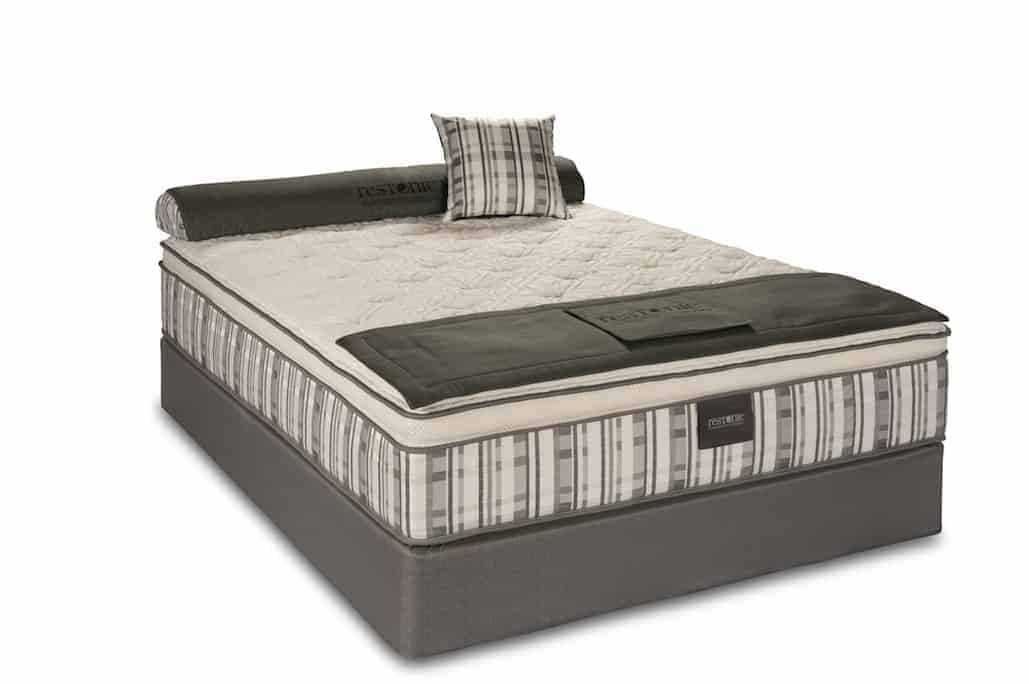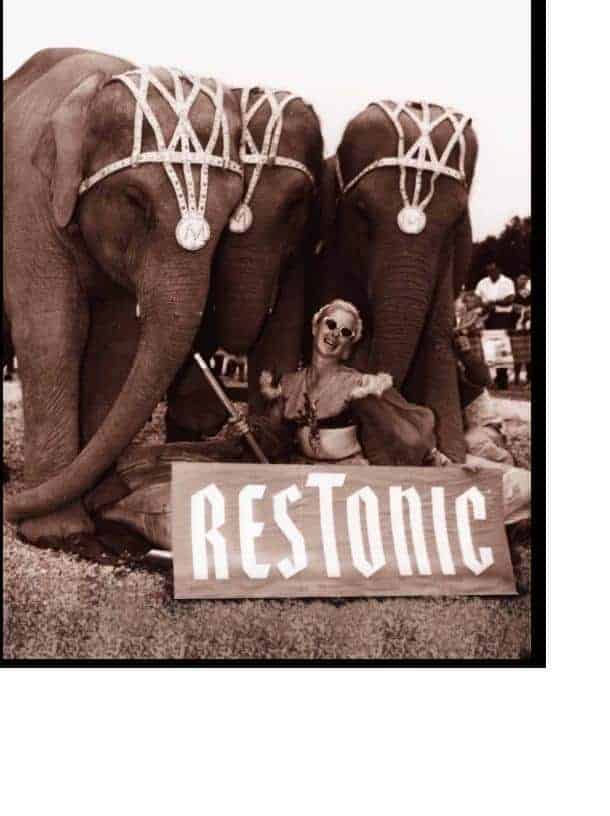
Change maker: Ron Passaglia, president and chief executive officer of Restonic Mattress Corp., helped usher in an era of decentralization when he joined the company in 2008.
BY DOROTHY WHITCOMB
As they mark the 75th anniversary of their company’s founding, executives at Restonic Mattress Corp. are in a celebratory mood. The licensing group has surpassed the overall bedding industry growth rate for the past four years and is confident future sales will be strong. To ensure that, the group plans to continue investing in the development of specialty and hybrid mattresses and is committed to expanding the number of top 100 furniture stores among its accounts.
Where it began
Restonic was founded in 1938 as the Triple Cushion Corp.
Bob Quinn is president of Restonic New Albany, a third-generation Restonic licensee in New Albany, Ind., and serves as the company’s unofficial historian.
“The company was founded by three manufacturers in the upper Midwest who had figured out how to make a better mattress,” Quinn says. “From the beginning, they were very product focused.”
Although the concept is now trademarked as the Marvelous Middle, the patented triple-cushion construction that company founders developed continues to be an integral part of the way Restonic builds beds.
“To build a better mattress, they focused on what mattered to consumers—comfort, support and durability,” Quinn says.
In 1946, the company’s name was changed to Restonic. Growth through the 1950s and 1960s, Quinn says, was spurred by visionary licensees such as Warren Rosing, who understood that the advent of television offered an unprecedented opportunity for branding.
| BRIEFLY | |
| Company | Restonic Mattress Corp. |
| Structure | Licensing group with factories in the United States and throughout the world |
| Specialty | Innerspring, specialty and hybrid offerings and the “Marvelous Middle” construction |
| Founded | Began as Triple Cushion Corp. in 1938 |
| Philosophy | “Supporting Dreams” |
| Learn more | www.restonic.com |
As part of its TV marketing efforts, Restonic hired Mel Blanc, famous for being the voice of Bugs Bunny, Daffy Duck and dozens of other cartoon characters, to be the commercial voice of the mattress brand starting in 1964. Ten years later, comedians Steve Allen and Jane Meadows signed on as the company’s celebrity “spokescouple.”
While marketing the brand has long been an important component of Restonic’s business plan, it did not become the linchpin that it is today until more recently. Along the way, the business plan evolved and the company’s structure changed with it. What began as a traditional manufacturing company morphed into a centralized licensing organization with all business functions, including manufacturing, purchasing and sales training, resting with Restonic staff.
In 2008, the structure changed again. Licensees, under the leadership of Ron Passaglia, who joined the company that year as president and chief executive officer, decided to decentralize.
They eliminated their brick-and-mortar headquarters in favor of teleconferencing equipment that connects two dozen domestic and international manufacturing facilities. In Restonic’s virtual world, headquarters is now wherever Passaglia and his BlackBerry come to rest—often Atlanta where he makes his home.
Tom Comer, who owns Restonic Buffalo and also produces the brand in a Fayetteville, N.C., plant, explains: “Our CFO is based in Chicago and Restonic Mattress Corp. rents space in Buffalo for the marketing and administrative people. The rest operate from home offices.”
The power of committees

Sales driver: The success of higher-end products, such as the ComfortCare Signature series, is boosting licensees’ bottom lines.
Restonic’s decentralized, bottom-up structure gains coherency through the participation of licensees in the decision-making process.
“Here’s how our licensing group differs from all of the others: We have two strong committees, the Product Marketing Committee and the Manufacturing Committee, that chart the course forward,” Passaglia says. “Because of the committee process, the organization is forced into reflection and no single thought process drives strategies.”
The Manufacturing Committee includes six licensees who, Passaglia says, have “excelled in manufacturing.” With input from the Product Marketing Committee, they work together to develop bed sets and make sure that they comply with federal flammability and other regulations.
Restonic Mattress Corp. oversees an annual audit by an outside group that evaluates each factory against Restonic quality and manufacturing standards. The results of the audit are shared at an annual meeting of all licensees.
“Instead of us dictating what is to be done in factories, we have a robust process,” Passaglia says. “We review the Brand Standards Manual and manufacturing processes and then share best practices. This enables consistency of product, which is important to consumers and retailers. It’s also important to the manufacturers because it allows them to have a more cost-effective product.”
The Product Marketing Committee is equally important. Composed of sales managers from five Restonic licensees and led by Passaglia, the committee is charged with designing all marketing programs and materials.
Sales managers, rather than owners, serve on that committee because, Comer says, they’re closer to Restonic’s current and prospective customers and, as a result, have the best understanding of the market. In addition, Comer notes, “all sales mangers of the top producers have equity in the company, which means there’s a real passion to drive the business.”
Although the committee process involves challenges, the results have been rewarding.
“When the core marketing group sees an opportunity and agrees on it, it doesn’t fail us,” Quinn says. “We’re diverse enough so that when we have consensus, we all run hard and fast to implement it. It’s magical.”
That approach and the Product Marketing Committee’s desire “to keep an open mind” are what led Restonic to “get heavily involved in investing in today’s media of choice, the Internet,” Quinn says.
The licensing group has embraced Internet marketing with the same enthusiasm that its predecessors embraced television. In addition to its website, Restonic has developed a vibrant social media program that includes Facebook, Twitter and Pinterest. To promote the brand and celebrate its 75th anniversary, the company is using these online platforms to run three consumer-driven contests.
Growth mode
The company’s decentralized structure is paying big dividends. Passaglia reports that Restonic’s annual sales have surpassed the bedding industry average for the past four years. In 2012, licensees posted sales of $119 million, $104 million of which came from sales of Restonic-branded products. That’s a 14.7% increase over 2011, Passaglia notes.
Growth, he says, is being propelled by a dramatic increase in the sale of higher-end products.
“In 2012, we saw a 51.3% increase in our premium business,” Passaglia says. “Growth is coming from specialty and hybrid sleep products and the extension of our ComfortCare collection featuring ComfortCare Select and the ComfortCare Signature series.”
The ComfortCare collection performs well “year after year,” Passaglia says. Queen-size bed sets in this group range in price from $599 to $999 for mattresses with open-coil construction and from $999 to $1,699 for ComfortCare Select mattresses, which feature individually wrapped coils. The hybrid ComfortCare Signature beds add TempaGel memory foam, gel-infused latex and gel-infused quilting foam, along with an AirFlow border. They have suggested retail prices from $1,299 to $1,999 in queen size.
Latex and memory foam beds from the HealthRest collection top out at $2,499. This collection also includes the best-selling TempaGel by Restonic series of gel-infused memory foam beds. The top bed is priced at $2,999.
Expanding the brand
In the United States, Restonic-branded products are produced by 11 licensees. There are an additional 10 licensees spread throughout the world. Individual manufacturer’s commitment to the brand is strong. Although some also manufacture private-label or other brands, most U.S. licensees produce the Restonic brand exclusively, Comer says.
Restonic is seeking licensees in Southern California, New York City and northern New England, according to Passaglia. He also would like to find new partners in Australia and throughout Europe and Russia.
“The strength of our licensing group is that the majority of our key licensees are financially sound and have a long-term heritage in the marketplace. We don’t just want to put more pins in a map,” Passaglia says. “We want to find long-term, robust, financially sound partners who are looking for a larger geographic area to serve.”
Passaglia says the company also is looking for partners who understand that Restonic’s “Supporting Dreams” tag line has “more meaning than just being a marketing term.”
He explains: “Restonic supports the dreams of customers by making a product that provides a great night’s sleep. We support the dreams of retailers by being responsive and giving them a product of greater value so they can be successful. And we support the dreams of our licensees by designing a great product that they can manufacture successfully. We live by that promise.”
Restonic’s promise to retailers translates into active involvement on multiple levels.
“We have to do whatever the retailer needs, which includes on-time delivery, responsive customer service, and creating and running their advertising programs,” Comer says. “Our sales reps are required to work on the retail floors during holiday weekends.”
Quinn adds: “Our sales managers are at the top of their games. We take the time to sit and listen and understand retailers’ local markets. Then we do whatever it takes to help them compete in their markets. Not only can we strategize, but we can deliver and we can do it quickly. If there is a strategic need for a major retailer, we can offer new product within two weeks.”
Restonic sells to local and regional sleep shops and to furniture stores. It counts 15 of the top 100 furniture stores among its accounts and plans to double that number in the next five years.
“With continued licensee support for our programs and strong implementation with our retailers, we expect to continue growing,” Passaglia says. “Our long-term goal is to double the company’s business in the next five years.”
Quinn doesn’t doubt that Restonic will do just that.
“We’re implementing our plan at a faster pace through retailers and consumers than ever before,” he says, “and we’re heading down a path where our image, performance and abilities have merged.”





